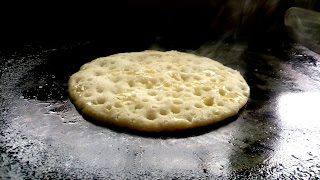INGREDIENTS:
1 cups Idli rice1 1/2 cups normal rice
1/2 cup Urad dal
2 tbsps fenugreek seeds /methi
1/2 cup sabakki/sabudana
1/2 cup Avalakki/poha
A glass of buttermilk
A pinch of sugar
Salt for batter.
( you can choose any convenient size of cup, as a glass, small steel cup or tumbler, but use the same cup to measure remaining ingredients )
Method.
Wash the dal and rice well, soak in clean water seperately for minimum of 5 hours or overnight.
Soak the Avalakki & sabakki seperately in buttermilk & the methi seeds along with urad dal.
After the soaking time, grind the urad dal and methi to a smooth batter.Dont add too much water while grinding. Keep aside. Next grind the rice, also to a smooth batter.Adding little water to enable easy grinding. At the last stage of finishing grinding the rice, add the Avalakki & sabakki soaked in buttermilk, which would have swollen after absorbing the buttermilk, grind well now and the batter will become thick at this stage.
Remove the batter and now mix both batters well, it should be thicker than the normal dosa batter. Use your hand to mix the batter.
Leave to ferment overnight in a big vessel to allow the fermented batter to rise without spilling.
Set dosa batter normally ferments quickly especially in the hot humid months, so you need to ferment just sufficiently or else the batter will turn sour.
When the batter has fermented well, add little water if it appears very thick along with salt and sugar, then take a ladle and mix the batter gently but well, not vigorously, as we will lose the aeration. We need to mix after fermentation to allow the top fluffy fermented batter to mix uniformly with the thick batter below as we do for idlis.
The consistency of batter will be slightly thinner than Idli batter.
To prepare the dosa, keep the griddle /tava to heat well, then take a ladle full of batter and pour slowly , without making the swirls as we normally do for regular dosas, the batter must fall thick and quickly, but not runny either.
As soon as the batter has fallen on the hot tava, you will see it spreading all around by itself, just like pancakes, bubbles appearing slowly , keep the flame on a low or very medium as the dosa gets browned very quickly, as soon as the top has got bubbles or holes, you may also close the dosa with a lid to enable quick cooking and forming more pore.. Closing the dosa with a lid also helps keep the set dosa, soft and moist.
Then check the dosa after removing the lid will appear soft, porous, flip only if necessary., flip over for a quick cooking, allow a little more medium flame now. Use oil/ghee as we would normally for regular dosas.
Set dosa is ready. Usually they appear uniform in perfect circles as it is not swirled or spread with a ladle, so they stack them together and serve hot with a dollop of butter, coconut chutney and vegetable sagu!!



No comments:
Post a Comment